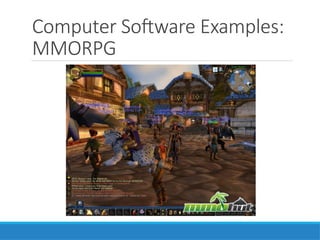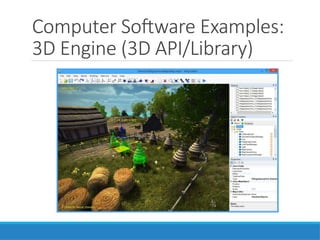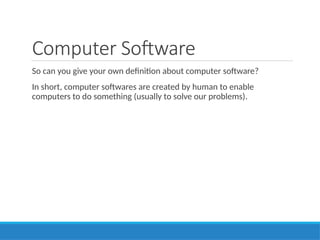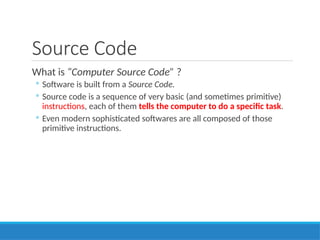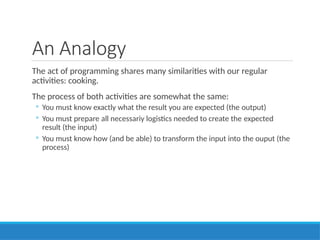Power Point Introduction To Programming 1
- 1. Object-Oriented Programming: Introduction To Programming DEPARTMENT OF INFORMATICS PARAHYANGAN CATHOLIC UNIVERSITY 14 AUGUST 2017
- 2. Definition Of Programming Computer Programming (or simply “programming”) is the process of writing the source code of a computer software (computer program) using a particular programming language. Many people also consider activities before and after it, such as solving the problem, designing, testing, debugging and maintaining the source code are also part of a programming activity
- 3. Computer Software Examples: Windows Calculator
- 4. Computer Software Examples: Media Player
- 5. Computer Software Examples: Comic Viewer
- 6. Computer Software Examples: Word Processor
- 7. Computer Software Examples: PC Games
- 8. Computer Software Examples: Social Network
- 9. Computer Software Examples: Journey Planner
- 12. Computer Software Examples: 3D Computer Graphics
- 13. Computer Software Examples: 3D Engine (3D API/Library)
- 14. Computer Software Examples: Weather Forecast
- 15. Computer Software Example Nowadays, softwares also run in different devices
- 16. Computer Software So can you give your own definition about computer software? In short, computer softwares are created by human to enable computers to do something (usually to solve our problems).
- 17. Source Code What is “Computer Source Code” ? ◦ Software is built from a Source Code. ◦ Source code is a sequence of very basic (and sometimes primitive) instructions, each of them tells the computer to do a specific task. ◦ Even modern sophisticated softwares are all composed of those primitive instructions.
- 18. Source Code
- 19. Source Code
- 20. Programming Language What is “Computer Programming Language” ? ◦ Instruction in the software’s source code must be understood by both the creator(human) and the computer ◦ Programming Language is created to enable “communication” between human and computer ◦ Several well known programming languages are: Java, C, C++, C#, PHP, etc ◦ Sometimes, several other languages (related to computer) are mistakenly regarded as a programming language: HTML, XML, SQL, . . .
- 21. Programming Finally, what is ”Programming”? ◦ Programming is the process of writing . . . ◦ Technically speaking, programming is a three-phase progress: 1. Problem-Solving Phase 1. Analysis and specification: understand and define the problem and identify what the solution must do 2. Design and develop a general solution/algorithm: specify step- by-step procedure that solve the problem
- 22. Programming ◦ Technically speaking, programming is a three-phase progress: 2. Implementation Phase 1. Create the source code: translate the algorithm into a programming language 2. Testing and debugging the program: run the program and check the result. If errors are found, analyze the source code and the algorithm to determine the source of error, and then make corrections 3. Maintenance Phase
- 23. The Implementation Phase In the implementation phase, the computer creates the software from the source code. Example: From C’s source code language to Executable/Software. Remember, this process is vary between different programming language, but the idea is the same.
- 24. An Analogy The act of programming shares many similarities with our regular activities: cooking. The process of both activities are somewhat the same: ◦ You must know exactly what the result you are expected (the output) ◦ You must prepare all necessariy logistics needed to create the expected result (the input) ◦ You must know how (and be able) to transform the input into the ouput (the process)
- 25. A Small Example Suppose we have a mug of beer and a glass of orange juice. How can we exchange the fillings, so in the end we have a mug of orange juice and a glass of beer? The process : 1. Prepare an additional container, for example: a goblet 2. Pour the orange juice into the goblet. Now the glass is empty. 3. Pour the beer into the empty glass. Now the glass is filled with beer, while the mug is empy. 4. Pour the orange juice form the goblet into the empy mug. 5. Throw away the goblet, because we do not need it anymore.
- 26. The Role of an Algorithm in Programming In order to solve a problem (using a computer), we need to specify the algorithm: ◦ it should contains a step-by-step task that the computer has to do to solve the problem ◦ it should be precise enough for the computer to “understand” (no ambiguity) ◦ the order of the task is important because each task is irreversible ◦ for every given input, the algorithm should yield a correct output After we have a correct algorithm, we finish the first phase of the programming progress
- 27. Object Oriented Programming The second phase is to translate the algorithm into the programming language (coding). There are two ways to do that ◦ Specify what procedures/actions are required to accomplish a specific task. ◦ Identify all objects which involved in the process of solving the problem The latter is known as Object Oriented Programming
- 28. Some Remarks This course is focusing on the coding part, using object oriented programming. We will use relatively easy algorithms and you will be forced to create you own algorithms. More advanced algortihms will be covered in details on other courses. We will only create (very) small-scale programs. Hopefully, you will be skilled enough to start creating medium-large scale programs or involved in team programming project. What the difference between this course and any other short-course (kursus) ? In short-course, you were taught to use a specific tools, whereas in this course, you will be taught to solve a problem.
- 29. So, What Programming is All About? Programming is about controlling the computer Programming is teaching computer how to do things Programming is problem solving (try to make computer do something useful) Programming is creative, you must find the best solution out of many possibilities Programming is concrete, you must provide detailed instructions to complete task (computer is dumb) Programming is about creating a computer software, not about how to use it
- 30. Why programming is very extremely important ? Programming is a gateway to the world of computer (and also the study about computer science) Programming helps you to understand how computer works Programming (and problem solving skill) are extremely useful in ALL computer science disciplines btw, wouldn’t it a bit disgrace for us, if you were graduated from a computer science/informatics department without having an adequate skill in computer programming ?
- 31. Finally What do you need to master the skill of programming (and of course, pass this course) ? ◦ pay attention in all of our course meetings, write down useful notes (do not depends on your friends’) ◦ do all the exercises by yourself, be honest ◦ patient, there might be no immediate result ... ◦ diligent, Singapore F1GP-alike is absolutely not applicable in this course ◦ ask questions, you do not have that opportunity during the exam ◦ do not give up yet, every person has a different learning curve ◦ careful: group-study might not be as helpful as you think ◦ in my experience: lot of practices on your own is the most important factor










